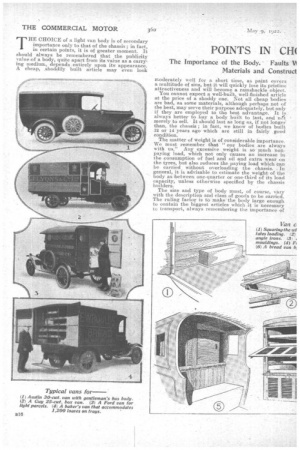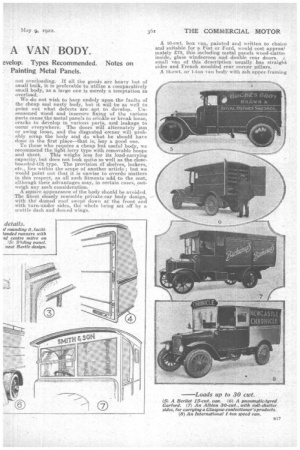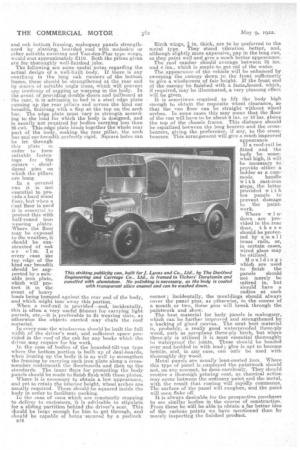POINTS IN CH(
Page 18

Page 19

Page 20

If you've noticed an error in this article please click here to report it so we can fix it.
A VAN BODY.
THE CHOICE of a light van body is of secondary importance only to that of the chassis ; in fact, in certain points, it is of greater moment. It should always be remembered that the publicity value:of a body, quite apart from its value as a carry' ing medium, depends entirely upon its appearance. A cheap, .shoddily built article may even look moderately well for a short time as paint covers a multitude of sins, but it will quickly lose its pristine attractiveness and will become a ramshackle object.
You. cannot expect a well-built, well-finished article at the price of a shoddy one. Not all cheap bodies are bad, as some materials, although perhaps not of the best, may serve their purpose adequately, but only if they are employed to the hest advantage. It is always better to buy a body built to last, and net merely to sell. It should last as long as, if not longer than, the chassis ; in fact, we know of bodies built 12 or 14 years ago which are still in fairly good condition.
The matter of Weight is of considerable importance, We must remember that "our bodies are always with us." Any excessive weight is so much. nonpaying load, which not only causes an increase in the consumption of fuel and .oil and extra wear on the tyres but also reduces the paying load which can be carried without overloading the chassis. .. In general, it is advisable to estimate the weight. of the body as between one-quarter or one-third of its load capacity, unless otherwise specified by the chassis builders.
The size and type of body must, of course, vary with the description and class of goods to be carried. The ruling factor is to make the body large enough to contain the biggest articles which it is necessary to transport, always remembering the importance of not overloading. If all the goods are heavy but of small bulk, it is preferable to utilize a comparatively small body, as a large one is merely a temptation to overload..
We do not wish to harp unduly upon the faults of the cheap and nasty body, but it will be as well to point out what defects are apt to develop. Unseasoned wood and insecure fixing of the various parts cause the metal panes to crinkle or break loose, cracks to develop in various parts, and leakage to occur everywhere. The doors will alternately jam or swing loose, and the disgusted owner will probably scrap the body and do what he should have done in the first place—that is, buy a good one. To those who require a cheap but useful body, we recommend the light lorry type with removable hoops and sheet. This weighs less for its load-carrying capacity, but does not look quite So well as the closeboarded-tilt type. The provision oef shelves, lockers, etc., lies within the scope of another article ; but we Would point out that it is unwise to overdo Matters in this respect, as all such fitments add to the cost, although their advantages may, in certain cases, outweigh any such consideration: A square appearance of the body should be avoided. The finest closely resemble private-car bodydesign, with the domed roof swept down at the front and with turn-under sides, the whole being set off by a scuttle dash and domed wings.
A 10-cwt. box van, painted and written to choice and suitable for a Fiat or Ford, would cost approx.; mately £75, this including metal panels wood-slatte,, inside, glass windscreen and-double rear doors. L small van of this description usually has straight aides and French moulded rear corner pillars.
A 15-cwt. or 1-ton van body with ash upper framing and oak bottom framing, mahogany panels strengthened by slatting,, boarded roof with moleskin or other suitable covering and Van-den-Plas type wings, would cost approximately £110. Both the prices given are for thoroughly well-finished jobs. The following are some useful notes regarding the actual design of a well-built body. If there is any overhang in the long oak runners of the bottom frame, these should be strengthened at the rear end by means of suitable angle irons, which will prevent any tendency of sagging or warping in the body. In the event of providing double doors and tailboard at the rear, it is advisable to bed in a steel edge plate running up the rear pillars and across the laind ear breadth, finishing with a flap at the top on the arch bar. The edge plate must vary in strength according to the load for which the body is designed, and is usually not required for bodies carrying less than
cwt. This et plate binds together the whole rear part of the body, y, making the rear pillar, the arch bar and ear breadth perfectly rigid. Square boles can be let through this plate in order to form suitable fastenings for the square shouldered pins on which the pillars are hung.
In a covered
an it is not essential to provide a hard wood Veer, but when a (.ea.1 floor is used it is essential to protect this with half-round iron wearing plates. Where the floor may be exposed to the weather, it should be constructed of oak or elna, In every case the top edge of the hind ear breadth
should be supported by a suitable iron plate, which will protect it in the event of heavy loads being bumped against the rear end of the body, and which might tear away this portion. When a roof-rail is provided—and, incidentally, this is often a very useful fitment for carrying light pareels etc.—it is preferable to fit wearing slats, as otherwise the objects carried may chafe the roof material.
In every case the windscreen should be built the full width of the driver's seat, and sufficient space provided in the roof of the cab for any books which the driver may require for his work.
in the ease of bodies of the boarded-tilt-van type where the bottom portion is built up of deal-boards, when ironing up the body it is as well to strengthen the framing by carrying each iron plate along a crossmember underneath the floorboards and then up the standards. The inner flaps for protecting the body panels should be made to finish flush with these plates. Where it is necessary to obtain a low appearance, and yet to retain the interior height, wheel arches are usually required. These should be squared inside the body in order to facilitate packing. In the case of vans which are constantly stopping to deliver to customers, it is advisable to stipulate for a sliding partition behind the driver's seat. This should be large enough for him to get through, and should be capable of being ' secure-d by a padlock Birch wings, in. thick, are to be preferred to the metal type. They stand vibration better, and, although slightly more expensive, pay in the long run, as they paint well and give a much better appearance. The roof camber should average between 3i ins. and 4 ins., which is ample -to get rid of the water.
The appearance of the vehicle will be enhanced by sweeping the canopy down to the front sufficiently to give a windscreen of fair height. If the front end of the canopy be finished with a facialleard. which, if required, may be illuminated, a very pleasing effect will be given. It is sometimes required to lift the body high enough to obtain the requisite wheel clearance, so that the van floor can be straight without wheel arches. In some cases this may mean that the floor of the van will have to be about 9 ins. or 10'ins. above the top of the chassis frame. This distance should be equalized between the long bearers and the crossbearers, giving the preference, if any, to the crossbearers. This arrangement will give a much improved
appearance.
If a roof-rail be fitted and the body be somewhat high, it will he necessary to provide either a ladder or a commode handle wit h east-iron steps, the latter provided with toe panels to prevent damage to the paintwork.
Where wi ndows are Provided in the rear door, these should be protected by .s mall brass rails, or, in certain cases, wired glass may be utilized.
Mouldings which are used
to finish the panels should not merely be mitred in, but should have a radius at each corner; incidentally, the mouldings should always cover the panel pins, as otherwise, in the course of a month or two, these pins will break through the paintavork and show.
The best material for body panels is mahogany, which can be further improved and strengthened by a backing of glued canvas. The next best material is, probably, a really good waterproofed three-ply wood, such as aeroplane three-ply birch, but where three-ply is utilized it is most essential thoroughly to waterproof the joints. These should be beaded over and bedded in with lead ; glue is apt to become brittle, and, in any case, c-an only be used with thoroughly dry wood. Metal panels are usually leau-coated iron. Where this type of panel is employed the paintwork should not, on any account, be done carelessly. They should receive a thorough priming coat, as chemical action may occur between the ordinary paint and the metal, with the result that rusting will rapidly commence. The surface of the panel will roughen, and the paint will soon flake off.
It is always desirable for the prospective purchaser to see similar bodies in the course of construction. From these he will be able to obtain a far better idea of the various points we have mentioned than Iv merely inspecting the finished product.




































